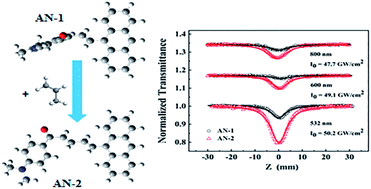Anthracene derivatives as broadband nonlinear optical materials: nonlinear absorption and excited-state dynamics analysis†
Abstract
Two anthracene derivatives, AN-1 and AN-2, with different π-bridge lengths were designed and synthesized to investigate their optical nonlinearities. The nonlinear absorption (NLA) properties of both derivatives were measured via the femtosecond Z-scan technique with the wavelength range from 532 nm to 800 nm. The reverse saturable absorption (RSA) of both compounds results from two-photon absorption induced excited-state absorption (TPA-ESA). At all wavelengths, the reverse saturable absorption of AN-2 is superior to that of AN-1 due to a better molecular planarity for AN-2. Compared with the results of AN-1, the two-photon absorption coefficient of AN-2 can be increased by nearly 8 times (from 0.182 × 10−2 cm GW−1 for AN-1 to 1.42 × 10−2 cm GW−1 for AN-2) at 600 nm by extending the π-bridge. The evolution of femtosecond transient absorption (TA) spectra reveals the relaxation process from the singlet local excited-state (LES) to charge transfer state (CTS) for both compounds. The results imply that anthracene derivatives may be potential candidates for applications in future laser photonics.



 Please wait while we load your content...
Please wait while we load your content...